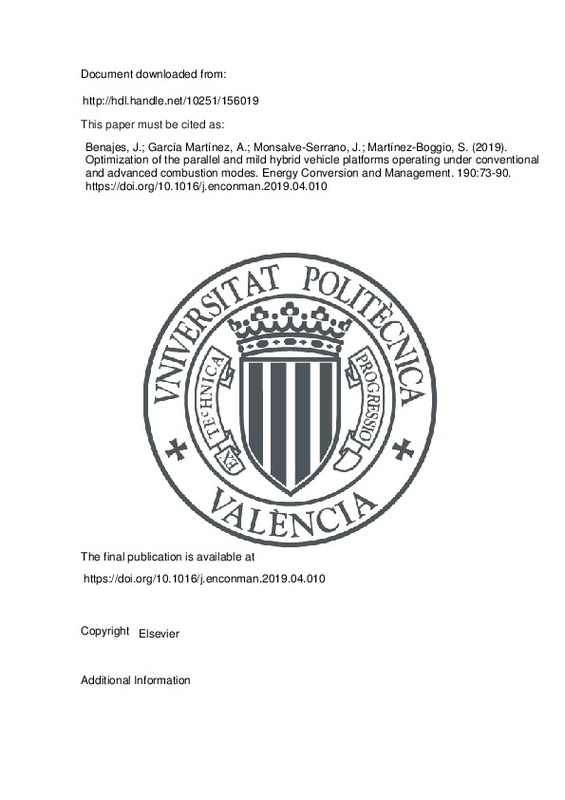JavaScript is disabled for your browser. Some features of this site may not work without it.
Buscar en RiuNet
Listar
Mi cuenta
Estadísticas
Ayuda RiuNet
Admin. UPV
Optimization of the parallel and mild hybrid vehicle platforms operating under conventional and advanced combustion modes
Mostrar el registro sencillo del ítem
Ficheros en el ítem
| dc.contributor.author | Benajes, Jesús
|
es_ES |
| dc.contributor.author | García Martínez, Antonio
|
es_ES |
| dc.contributor.author | Monsalve-Serrano, Javier
|
es_ES |
| dc.contributor.author | Martínez-Boggio, Santiago
|
es_ES |
| dc.date.accessioned | 2020-11-28T04:31:49Z | |
| dc.date.available | 2020-11-28T04:31:49Z | |
| dc.date.issued | 2019-06-15 | es_ES |
| dc.identifier.issn | 0196-8904 | es_ES |
| dc.identifier.uri | http://hdl.handle.net/10251/156019 | |
| dc.description.abstract | [EN] The stringent regulations, increased global temperature and customer demand for high fuel economy have led to rapid developments of different alternative propulsion solutions in the last decade, with special attention to the electrified vehicles. The combination of electric machines with conventional powertrains allows to diversify the powertrain architectures. In addition, alternative combustion modes as reactivity controlled compression ignition (RCCI) have been shown to provide simultaneous ultra-low NOx and soot emissions with similar or better thermal efficiency than conventional diesel combustion (CDC). Therefore, the combination of both technologies creates a promising horizon to be implemented in commercial vehicles of the near future. In this work, experimental and numerical simulations were combined to study the potential of the parallel full hybrid electric vehicle (P2-FHEV) and mild hybrid vehicle (MHEV) to obtain lower fuel consumption and NOx emissions than a conventional powertrain in the Worldwide Harmonized Light Vehicles Cycle (WLTC). The hybrid vehicles are simulated with both CDC and diesel-gasoline RCCI combustion engines as power source. Each powertrain was optimized in terms of components (battery, electric motors...) capacity, internal combustion engine operative points, energy management strategy and gear ratios. The results show a significant fuel consumption reduction as the complexity of the hybrid system increases. The parallel architecture, which represents the most complex hybrid system tested in this work, allows obtaining a fuel consumption reduction of around 20% as compared to CDC. The dual-mode CDC-RCCI concept showed improvements in NOx and soot emissions with comparable values in terms of energy consumption and CO2 emissions than CDC. Additionally, the mild hybrid technology with the functionality of start-stop, torque assist and regenerative braking showed an acceptable balance between complexity and fuel consumption gain. | es_ES |
| dc.description.sponsorship | The authors want to express their gratitude to General Motors Global Research & Development for providing the engine used to acquire the experimental data used in this investigation. The authors acknowledge FEDER and Spanish Ministerio de Economia y Competitividad for partially supporting this research through TRANCO project (TRA2017-87694-R). The authors also acknowledge the Universitat Politecnica de Valencia for partially supporting this research through Convocatoria de ayudas a Primeros Proyectos de Investigation (PAID-06-18). | es_ES |
| dc.language | Inglés | es_ES |
| dc.publisher | Elsevier | es_ES |
| dc.relation.ispartof | Energy Conversion and Management | es_ES |
| dc.rights | Reconocimiento - No comercial - Sin obra derivada (by-nc-nd) | es_ES |
| dc.subject | Low temperature combustion | es_ES |
| dc.subject | Mild hybrid vehicle | es_ES |
| dc.subject | Full hybrid vehicle | es_ES |
| dc.subject | Dual-fuel combustion | es_ES |
| dc.subject | Driving cycles | es_ES |
| dc.subject.classification | MAQUINAS Y MOTORES TERMICOS | es_ES |
| dc.title | Optimization of the parallel and mild hybrid vehicle platforms operating under conventional and advanced combustion modes | es_ES |
| dc.type | Artículo | es_ES |
| dc.identifier.doi | 10.1016/j.enconman.2019.04.010 | es_ES |
| dc.relation.projectID | info:eu-repo/grantAgreement/UPV//PAID-06-18/ | es_ES |
| dc.relation.projectID | info:eu-repo/grantAgreement/AEI/Plan Estatal de Investigación Científica y Técnica y de Innovación 2013-2016/TRA2017-87694-R/ES/REDUCCION DE CO2 EN EL TRANSPORTE MEDIANTE LA INYECCION DIRECTA DUAL-FUEL DE BIOCOMBUSTIBLES DE SEGUNDA GENERACION/ | es_ES |
| dc.relation.projectID | info:eu-repo/grantAgreement/UPV//SP20180148/ | es_ES |
| dc.rights.accessRights | Abierto | es_ES |
| dc.contributor.affiliation | Universitat Politècnica de València. Departamento de Máquinas y Motores Térmicos - Departament de Màquines i Motors Tèrmics | es_ES |
| dc.description.bibliographicCitation | Benajes, J.; García Martínez, A.; Monsalve-Serrano, J.; Martínez-Boggio, S. (2019). Optimization of the parallel and mild hybrid vehicle platforms operating under conventional and advanced combustion modes. Energy Conversion and Management. 190:73-90. https://doi.org/10.1016/j.enconman.2019.04.010 | es_ES |
| dc.description.accrualMethod | S | es_ES |
| dc.relation.publisherversion | https://doi.org/10.1016/j.enconman.2019.04.010 | es_ES |
| dc.description.upvformatpinicio | 73 | es_ES |
| dc.description.upvformatpfin | 90 | es_ES |
| dc.type.version | info:eu-repo/semantics/publishedVersion | es_ES |
| dc.description.volume | 190 | es_ES |
| dc.relation.pasarela | S\382274 | es_ES |
| dc.contributor.funder | Agencia Estatal de Investigación | es_ES |
| dc.contributor.funder | European Regional Development Fund | es_ES |
| dc.contributor.funder | Universitat Politècnica de València | es_ES |







![[Cerrado]](/themes/UPV/images/candado.png)

